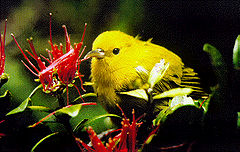- ʻAnianiau
-
ʻAnianiau 
Conservation status Scientific classification Kingdom: Animalia Phylum: Chordata Class: Aves Order: Passeriformes Suborder: Passeri Parvorder: Passerida Family: Fringillidae Subfamily: Drepanidinae Tribe: Hemignathini Genus: Magumma (disputed) Subgenus: Hemignathus (Magumma) (disputed)
Mathews, 1925Species: parva Binomial name Magumma parva
(Stejneger, 1887)Synonyms (Sub)Genus:
"Rothschildia" Wilson & Evans, 1899 (nomen nudum; non Grote, 1896: preoccupied)
Species:
Himatione parva Stejneger, 1887
Magumma parva (Stejneger, 1887) (but see text)
Viridonia parva (Stejneger, 1887)The ʻAnianiau (Magumma parva) is a species of finch in the Hawaiian honeycreeper subfamily, Drepanididae, that is endemic to upper elevation forests on the island of Kauai.[2] It is a brightly-plumaged yellow bird and, at 10 centimetres (3.9 in) in length, the smallest Hawaiian honeycreeper.[3] Its call is a pair of notes, tew-weet, while its song is a triple of wee-see, wee-see, wee-see.
This species seems to be rather distantly related to the typical Hemignathus (the ʻamakihis and nukupuʻus). It is placed in the monotypic genus Magumma.[4]
Contents
Habitat
ʻAnianiau are found in mesic and wet forests at elevations above 600 m (2,000 ft). The highest densities occur above 1,100 m (3,600 ft). Dominant tree species in its habitat include koa (Acacia koa), ʻōhiʻa lehua (Metrosideros polymorpha), ʻōlapa (Cheirodendron trigynum), and lapalapa (C. platyphyllum).[2]
Diet
The feeds on nectar from the flowers of plants such as ‘ōhi‘a lehua (Metrosideros polymorpha), ‘ōhelo (Vaccinium spp.), and ‘alani (Melicope spp.). It will also take arthropods from trees, shrubs, or vines.[2]
Breeding
The ‘Anianiau has had a breeding season between the late winter and early spring. The female will make a small cup shaped nest made of lichens in a O’hia tree. It will then lay one to two eggs inside which will hatch in about thirteen days. The small yellow chicks will leave the nest in three weeks, but while in the nest they will be feed on a mainly protein diet of caterpillars.
Discovery
The ʻAnianiau first discovered in the 1830s, but was not seen again for another fifty years. This species was not well studied until the 1960s.
Conservation
The range of the ʻAnianiau has contracted by 85%, as it previously could be found in all forests of Kauai. Habitat degradation and invasion by non-native plants are the most significant threats to this species. Mosquito-transmitted diseases, such as avian malaria and fowlpox, are very rarely observed in captured ʻAnianiau, so they may not be a major cause of mortality of the bird. Predation by rats and cats is possible but has not been documented. This species is protected in the Alakai Wilderness Preserve and surrounding environs as well as Waimea Canyon[2] and Koke'e State Parks.[3]
References
- ^ "Hemignathus parvus". IUCN Red List of Threatened Species. Version 2009.2. International Union for Conservation of Nature. 2008. http://www.iucnredlist.org/apps/redlist/details/149617. Retrieved 30 January 2010.
- ^ a b c d "‘Anianiau or Lesser ‘Amakihi" (PDF). Hawaii's Comprehensive Wildlife Conservation Strategy. State of Hawaii. 2005-10-01. http://www.state.hi.us/dlnr/dofaw/cwcs/files/NAAT%20final%20CWCS/Chapters/Terrestrial%20Fact%20Sheets/Forest%20Birds/anianiau%20NAAT%20final%20!.pdf. Retrieved 2009-02-14.
- ^ a b "Anianiau - Magumma parva". BirdLife Species Factsheet. BirdLife International. http://www.birdlife.org/datazone/species/index.html?action=SpcHTMDetails.asp&sid=8908&m=0. Retrieved 2009-02-14.
- ^ [1] Forty-ninth Supplement to the American Ornithologists’ Union Check-list of North American Birds, Banks, et al. (2008).
External links
- BirdLife Species Factsheet.
- ʻAnianiau videos, photos and sounds on the Internet Bird Collection
Categories:- IUCN Red List vulnerable species
- Hemignathus
- Fringillidae
- Birds of Hawaii
- Endemic fauna of Hawaii
- Animals described in 1887
Wikimedia Foundation. 2010.

